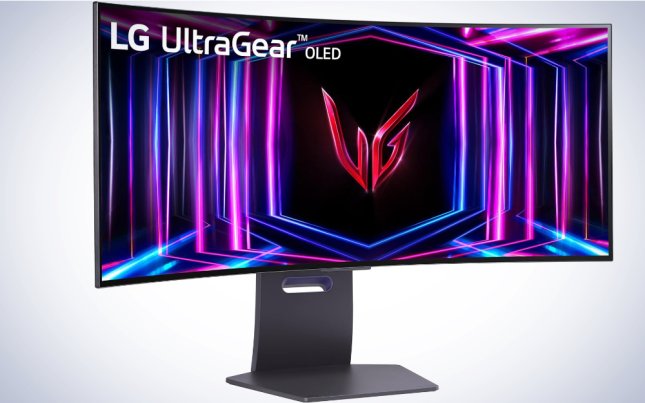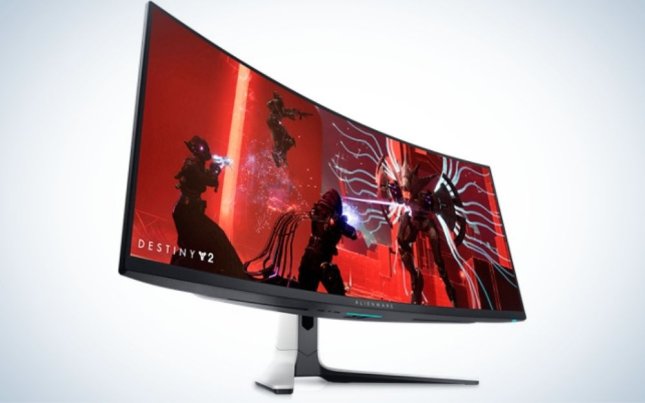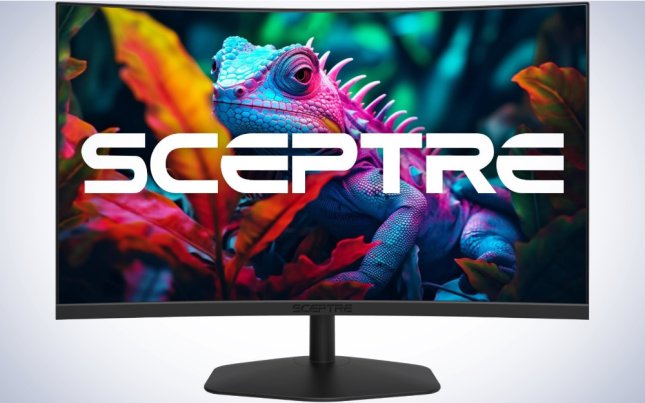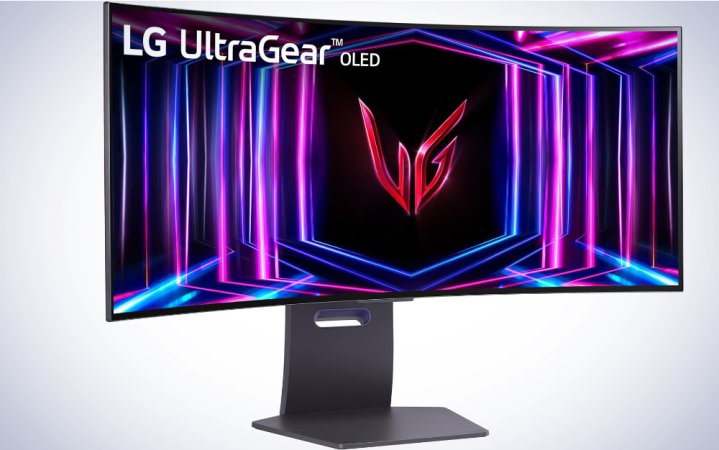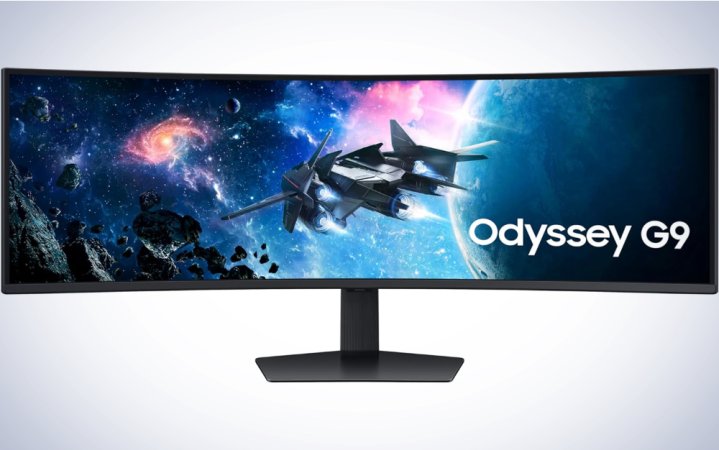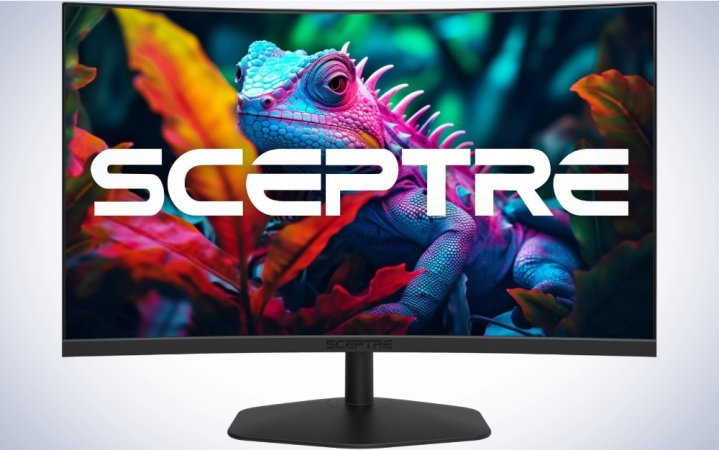We may earn revenue from the products available on this page and participate in affiliate programs. Learn more ›
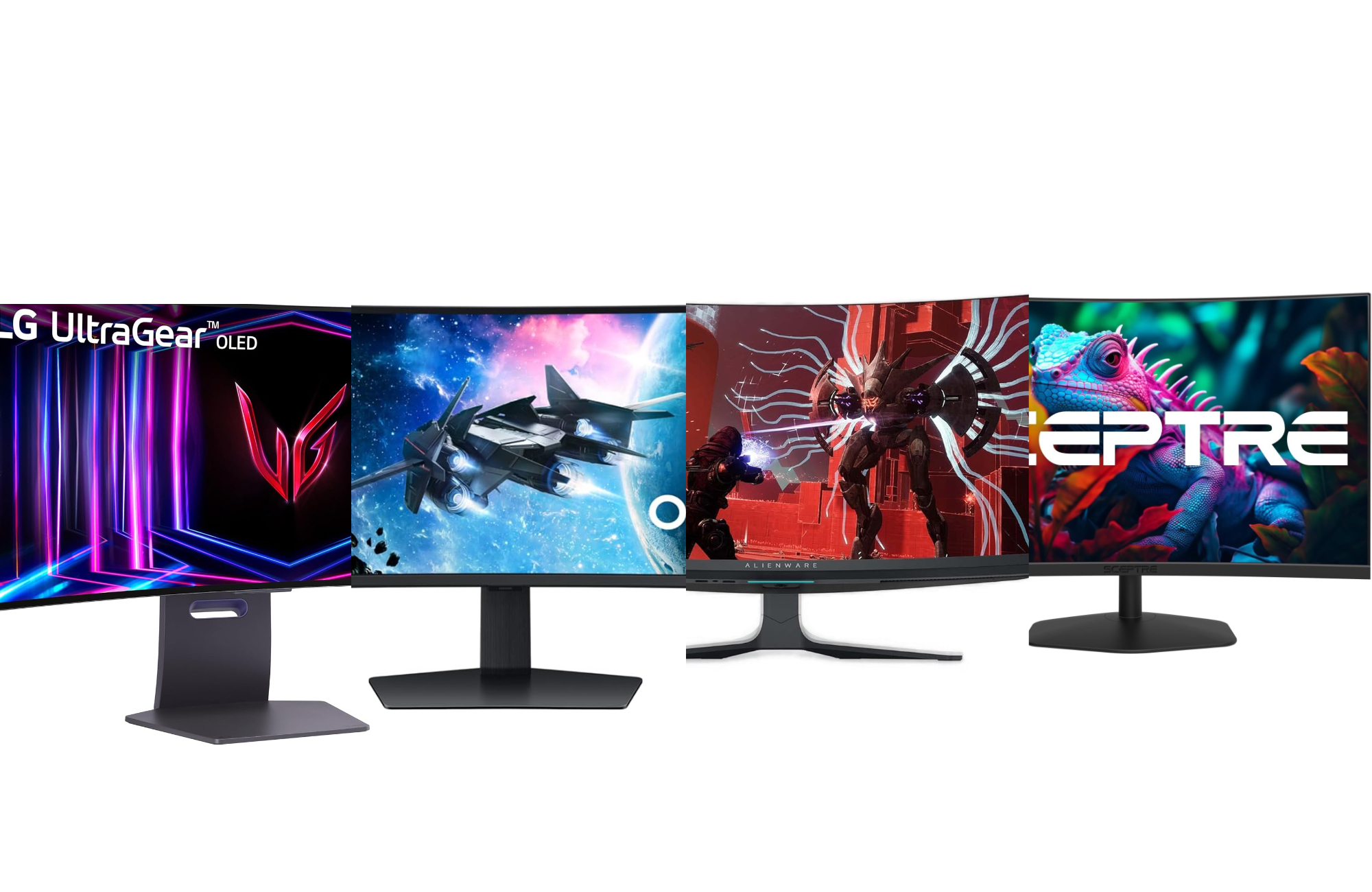
Whether you’re gaming or taking on a big project at work, upgrading to a curved monitor can elevate your computing experience. While using one feels a bit different and may not be for everyone, an increasing number of people swear by them. The graceful arc of a curved display—like the LG 34GS95QE, our best overall pick—draws you further into the experience, increasing your immersion and blocking out distractions. The best curved monitors feature all the impressive specs and features of any other display while bringing a few unique tricks all their own.
- Best overall: LG 34GS95QE
- Best for gaming: Dell Alienware AW3423DW
- Best for work: Dell UltraSharp U3425WE
- Best 4K: Gigabyte M32UC
- Best ultrawide: Samsung G9 LS49CG954ENXZA
- Best budget: Sceptre C248W-FW100T
How we chose the best curved monitors
I’ve worked in gaming and tech journalism since 2013. During that time, I’ve evaluated a wide range of monitors, from affordable flat panels to luxurious curved ultrawides. Covering displays and computers for sites like IGN, Reviewed, and Tom’s Hardware, I’ve built a deep understanding of what makes a monitor great.
Our selections for the best curved monitors are the product of extensive testing and research. Beyond testing and reviewing many of these monitors, I took a deep look at the most important specs: screen size, resolution, refresh rate, response time, and the core features that separate a great display from a basic one. I also turned to reviews from experts and impressions from real customers to see how they stacked up in dedicated performance tests and real-world scenarios.
The best curved monitors: Reviews & Recommendations
Now that you have a good handle on the monitor-buying basics, let’s talk about the best curved monitors you can buy. Even with all the knowledge we’ve shared, finding the right monitor may still feel like a daunting task. Our picks, selected through testing and extensive research, are a great place to start (and end) your search.
Best overall: LG 34GS95QE
Why it made the cut: LG’s 34GS95QE delivers a great picture and outstanding value.
Specs
- Screen size: 34-inches
- Curve: 800R
- Resolution: 2560×1440
- Panel type: OLED
- Brightness/HDR: VESA DisplayHDR 400
- Refresh rate: 240Hz
- Response time: .03ms
Pros
- OLED display for perfect contrast
- Deep, immersive curve
- Crisp 1440p resolution
- Esports-grade 240Hz refresh rate
Cons
- 800R curve may be too deep for some people
- Expensive
LG’s 34GS95QE offers the best performance-to-value ratio of any curved monitor we found, and it’s an excellent choice for gamers and graphic designers alike. Its high-resolution OLED panel will deliver perfect black levels, while VESA DisplayHDR True Black 400 will deliver stunning colors. These features are essential for video and photo editors who need to ensure what they see on screen will be reflected on TVs and physical prints.
The monitor supports NVIDIA’s G-Sync, AMD’s FreeSync Premium Pro, Vesa Certified Adaptive Sync, and Vesa Certified Clear MR, all of which ensure peak gaming performance by eliminating graphical glitches like screen tearing. These features, combined with the display’s 240Hz refresh rate and astonishing .03ms response time, mean this monitor can be used by professional eSports gamers who require the highest levels of fidelity.
One of the 34GS95QE’s divisive features is its deep 800R curve. It’ll take up most of your peripheral vision and runs a greater risk of catching light and reflecting it directly at your face. You can negate this by adjusting the monitor’s height, tilt, and swivel, but the display may be jarring if you’ve only used flat panel displays or screens with a gentler curve. This monitor’s large size may also pose a problem if you’ve got limited desk space, though LG offers it in a 39-inch configuration if you’ve got room to spare.
LG deserves credit for packing all of these features into a curved monitor that clocks in at well under $1,000—even the larger model squeezes under that threshold—though it’s definitely designed for the enthusiast or professional crowd. If you find yourself in either of those categories, and need a deeply curved screen for business and pleasure, LG’s 34GS95QE is the no-compromise monitor you’ve been looking for.
Best for gaming: Dell Alienware AW3423DW
Why it made the cut: The Alienware AW3423DW’s fast, color-rich OLED screen makes games look better than ever; it’s expensive but very impressive.
Specs
- Screen size: 34.18-inch (Ultrawide)
- Curve: 1800R
- Resolution: 3440×1440 (21:9)
- Panel type: QD-OLED
- Brightness/HDR: 1000-nit peak brightness (DisplayHDR 400 True Black)
- Refresh rate: 175Hz
- Response time: 0.1ms
Pros
- QD-OLED panel enables incredible contrast and sharpness
- 1000-nits peak brightness
- Quantum dots for rich, accurate colors
- G-Sync Ultimate
Cons
- Very expensive
- Doesn’t work well with PS5
- No HDMI 2.1 ports
The Alienware AW3423DW is a rare curved display indeed. It features a Quantum Dot-enhanced OLED panel. Standard OLED screens are known for lacking the brightness of conventional displays, but Quantum Dot technology enhances the screen’s inherent brightness, allowing the AW3423DW to hit an HDR-bright 1000 nits. It only achieves that maximum brightness in small spots on the monitor but is still more than capable of generating quality HDR gameplay.
You won’t have to worry about artifacts dragging down your gaming experience with the AW3423DW. With a ridiculously fast 0.1ms response time, ghosting just isn’t an issue for this display. A 175Hz refresh rate and Nvidia’s G-Sync Ultimate certification ensure excellent picture quality without screen tearing.
It isn’t perfect, though. The AW3423DW has a small number of flaws, particularly for console players who would pair it with a PlayStation 5. It lacks HDMI 2.1, for example, so it can’t play games in 4K at 120Hz over HDMI cable. It also can’t downscale 4K content, so the PS5 can only run in 1080p on the monitor. (Luckily, there are monitors particularly well-suited to PS5.)
The Alienware AW3423DW is one of a few OLED gaming monitors in 2024. As a result, the distinctive, high-performance panel comes with a very steep price tag. If you’re a PC player who wants to see the sharpest possible picture on a monitor, though, it’s the best splurge and worth it.
Best for work: Dell UltraSharp U3425WE
Why it made the cut: The Dell Ultrasharp U3425WE can replace multiple monitors and comes with productivity-enhancing features
Specs
- Screen size: 34.1-inch (Ultrawide)
- Curve: 1900R
- Resolution: 3440×1440 (21:9)
- Panel type: IPS
- Brightness/HDR: 300 nits
- Refresh rate: 60Hz
- Response time: 8ms
Pros
- Connects via USB-C
- Built-in KVM lets you switch between two PCs with one mouse and keyboard
- Useful software quickly divides screen space
- Remembers window positions between uses
Cons
- Expensive
- Low brightness
Looking to replace your multi-monitor setup for work with a single ultrawide monitor? The 34-inch Dell Ultrasharp U3421WE is as tall as a standard 27-inch monitor and provides roughly eight inches of extra width on either side, so you have plenty of space to work. It also features some productivity-enhancing software that can partition that space into 38 different configurations for up to five windows. You’ll be able to see everything you need to work quickly and efficiently. When you’re done for the day, the software can re-open those windows, allowing you to pick up right where you left off.
It isn’t uncommon for monitors to feature a couple of extra USB ports for your peripherals, but the U3425WE not only connects via USB-C but also doubles as a bona fide USB-C hub. It features two USB-C ports, one of which empowers you to connect and charge a laptop. There are also a whopping five USB 3.0 ports (one upstream and four downstream), to connect all of your peripherals and transfer large files. There’s even an Ethernet port to connect to your office’s network.
It may not be quite as wide as two 27-inch monitors, but the Dell Ultrasharp U3425WE makes a strong case for optimizing a professional home office with a curved ultrawide display.
Best 4K: Gigabyte M32UC
Why it made the cut: The Gigabyte M32UC is a big screen with a crisp 4K picture and features to spare.
Specs
- Screen size: 31.5-inch
- Curve: 1500R
- Resolution: 3840×2160 (4K)
- Panel type: SuperSpeed VA
- Brightness/HDR: DisplayHDR 400
- Refresh rate: 160Hz
- Response time: 1ms
Pros
- Crisp 4K visuals in a large viewing area
- Fast refresh rate
- Great color coverage
- Built-in KVM
Cons
- Limited HDR performance
- Minor ghosting without overdrive
Curved 4K monitors usually get expensive quickly, and the Gigabyte M32UC balances performance, features, and price better than most displays out there. At $599, it isn’t cheap by any stretch, but you get a color-rich gaming display with a ton of great features at almost half the price of some others on this list, making it the best value pick. You may have to adjust a couple of settings to make the most of it, but once you do, you’ll see that it’s a hidden gem among ultrawide gaming monitors.
SuperSpeed VA panel. Unlike traditional VA panels, the M32UC’s SuperSpeed VA panel gives it an unexpectedly low 1ms response time. It’s also fast, with a 160Hz refresh rate, which is high for a 4K display. With 93% DCI-P3 wide color gamut and 123% sRGB, it offers incredible color depth and accuracy, which is great for creatives. If you’d like to connect to a second PC for streaming or home office use, it also features a built-in KVM to swap your peripherals between devices quickly. The monitor also features a full suite of competitive gaming features, like a “Black Equalizer” that helps you peek into shadows and an FPS monitor that can overlay on any game.
There are some important trade-offs with the M32UC that you should know before you buy in. First, with 8-bit color and only 400 nits of brightness, it can’t really handle HDR gameplay. Some users have also reported minor ghosting with Overdrive disabled, but that’s a quick fix within its settings menu. Even with these shortcomings, the M32UC is an outstanding choice if you’re shopping for a 4K monitor with an immersive curve.
Best ultrawide: Samsung G9 LS49CG954ENXZA
Why it made the cut: Samsung’s G9 LS49CG954ENXZA is the massive curved monitor you’ve been looking for.
Specs
- Screen size: 49-inch (Ultrawide)
- Curve: 1000R
- Resolution: 3440×1440 (21:9)
- Panel type: VA
- Brightness/HDR: DisplayHDR 1000
- Refresh rate: 240Hz
- Response time: 1ms
Pros
- Ultra-high brightness with 1000 certification
- Mammoth size will take up your entire peripheral vision
- AMD FreeSync Premium Pro support
Cons
- Expensive
Samsung is pushing the concept of curved monitors to the brink with its 49-inch G9 LS49CG954ENXZA, a display twice the width of other displays we recommend. Yes, you’ll need a lot of space on your computer desk to accommodate it, but the benefits will become immediately apparent. We’re in love with the multiple full-sized windows we can keep open simultaneously on Samsung’s 34-inch OLED G8 monitor, and this one is even better at replicating the experience of using multiple separate displays. This monitor even supports a picture-in-picture mode when watching videos, if you’d like to watch two at the same time without worrying about manual window resizing.
While size is the G9 LS49CG954ENXZA’s obvious strength, it’s not the only reason to recommend it. The display’s high resolution, refresh rate, and support for both AMD FreeSync Premium and HDR10+ make it a good choice for those who want to play the latest games on a big screen. You’ll need to check whether the games you play have a dedicated 32:9 aspect ratio graphics mode for the best experience; otherwise, you’ll be left with big blank spaces on either side of it.
If you take advantage of this monitor’s generous port selection by plugging in multiple peripherals, you’ll appreciate its auto switch mode, which detects when you’re using a specific input and jumps to it. This is more convenient than manually moving from input to input using buttons on the display.
Professionals who can successfully multitask or want to keep all of an application’s tools on-screen at all times will be able to take full advantage of what Samsung’s G9 LS49CG954ENXZA has to offer, while gamers will also find a lot to like. Its size is either its greatest strength or biggest weakness, but if you need an ultrawide curved monitor that is truly ultra-wide, you won’t find a better option.
Best budget: Sceptre C248W-FW100T
Why it made the cut: The Sceptre C248W-FW100T offers a lot of performance for a curved monitor under $110.
Specs
- Screen size: 24-inch
- Curve: 1500R
- Resolution: 1920×1080
- Panel type: VA
- Brightness/HDR: 250 nits
- Refresh rate: 100Hz
- Response time: 1ms
Pros
- 100Hz refresh rate
- Built-in speakers
- Good color coverage
Cons
- No HDR
- Low pixel density
If you’re on a limited budget, Sceptre’s C248W-FW100T is the obvious curved monitor choice. Clocking in at just under $110, it offers relatively impressive performance with few limitations. Yes, it’s a 1080p monitor in a world that’s moved to QHD or 4K, and it’s lacking HDR, but those won’t make meaningful differences in day-to-day tasks like browsing the web or streaming videos. The monitor’s low cost also makes it a good entry point for those who’ve been curious about curved monitors but haven’t taken the plunge. Its 1500R curve will envelop your field of view nicely.
Sceptre makes up for this monitor’s relatively low resolution by bumping its refresh rate up to 100Hz and offering a 1ms response time. These specs make the E255B-FWD240 a solid choice for gamers, though the lack of features like AMD’s FreeSync technology, which helps the monitor keep up with fast-paced action games like first-person shooters to ensure graphical glitches like screen tearing don’t occur, means hardcore players will be left wanting.
Graphic designers or video editors will appreciate that this monitor supports 100% of the sRGB color gamut, so the colors you see on screen will match their prints. This isn’t a reference color monitor, but this feature is nice, considering the C248W-FW100T doesn’t support any high dynamic range. With a peak brightness of 250 nits, this monitor may appear dim when used in environments with a lot of natural light, but won’t be impacted in dimmer rooms.
While these limitations may be deal breakers for more expensive monitors, they’re easy to forgive, given this monitor’s excellent price.
What to consider when buying a curved monitor
Once a niche offshoot of conventional PC displays, the curved monitor has become an increasingly popular gaming and office work option. Going for a curved monitor adds a couple of extra specs to the long list of considerations you want to keep in mind when buying any monitor. We’ll walk you through the basics, so you can make your own decision when you’re ready to choose curved monitors.
Curve arc
The big difference between picking a curved display and a standard flat panel is the curve itself. Just like the size of the monitor, the depth of the display’s arc varies from model to model.
The arc of a curved display is measured using the distance from the outer edge of the screen to its center. That number, measured in millimeters, is expressed as the monitor’s Radius (R) and indicates the recommended viewing distance to experience that curve’s benefits fully. The lower the radius, the deeper the curve of the monitor vs. flat. The deeper the curve, the more immersive your viewing experience will feel.
Curvatures range from a gentle 3000R bend to minimize how often you twist your neck to a noticeable curve that can enhance the immersive qualities of first-person games. Some gaming monitors drop down to 1000R. As this excellent explainer from BenQ describes, 1000R is the same curve as the human eye and should theoretically feel most “correct,” though such a deep curve can also be the hardest to adapt to.
Curved monitors are an acquired taste. It’s hard to know whether you’ll like a curved monitor, or what curve arc you’ll prefer without seeing them in person. Pictures just can’t replace the experience of sitting before one and seeing what each curve feels like for yourself. We recommend stopping by the electronics section of your retailer to see for yourself. If that’s not possible, be sure to buy from a retailer with a friendly return and exchange process.
Resolution
Beyond the curve’s arc, there’s no major difference between picking a curved monitor and any other. There are three core specs that we look at first when picking any PC display: resolution, screen size, and refresh rate.
Resolution refers to how many pixels your display uses to generate an image. All other things being equal, a higher resolution enables a sharper, more detailed image. Manufacturers currently stick to three primary resolutions for all widescreen (16:9) monitors: The baseline is 1920 x 1080 pixels, more commonly known as 1080p. The middle option, which we frequently recommend for gaming, is 2560 x 1440 pixels (you may see manufacturers call this 1440p, or QHD). Lastly, you have 3840 x 2160 pixels, also known as 4K. Unlike TVs, where 4K has become the standard, 4K monitors are still luxury and usually expensive.
If you plan on using your monitor for gaming, remember that higher resolutions require more powerful hardware to run well. If you’re a gamer but aren’t sure what resolution will work best for you, download and run a selection of the best benchmarks to grasp your system’s performance better.
Screen size
Curved displays aim to take up more of your peripheral vision, so unlike conventional widescreen monitors, we recommend going with the largest display that feels comfortable for you.
That recommendation comes with a caveat: There is a correlation between screen size and resolution. Larger displays need more pixels to achieve the same level of sharpness as their smaller counterparts. So, while a larger screen will enhance the benefits of using a curved display, we only recommend you do so if you can also afford to scale up to 1440p or 4K for a screen above 27 inches.
With curved displays in particular, it also makes sense to consider whether you’d be interested in the standard, 16:9 widescreen aspect ratio, or a 21:9 ultrawide monitor. Ultrawide monitors extend the horizontal viewing area without making the display taller than a traditional display, which pushes the edges of the screen closer to your peripheral vision. Since curved displays work best when they extend to the outer edges of your field of view, the ultrawide form factor enhances the benefits of a curved panel. Pairing the two unconventional form factors often leads to a more expensive display, but a large curved ultrawide creates enough screen space to replace two monitors in most setups. It’s expensive, but a unique pleasure.
Refresh rate
For gaming, refresh rate often feels just as important as screen size and resolution. Refresh rate, measured in hertz (Hz), refers to how many times the screen updates the image on screen each second. Productivity monitors usually stick to basic 60Hz-75Hz, since smooth animation isn’t considered a priority. For gaming, however, a higher refresh rate allows games to run at a higher frame rate, making them look smoother and reducing motion blur.
In general, we look for gaming monitors with a 144Hz refresh rate or higher. For office work, a little bump to refresh rate is a nice luxury, but not a crucial feature.
Panel type
The physical screen panel can impact a monitor’s color accuracy, contrast, and responsiveness. Aside from a few exceptions—some of which you’ll see on this list—monitors rely on one of three panel types:
In-Plane Switching, or IPS, panels have the best colors and widest viewing angles of the three types. Because of this, they have become a staple in the creative industries and are a popular choice for digital artists. At the same time, IPS panels typically have slower response times and low contrast.
Twisted Nematic, or TN, panels are traditionally regarded as the “fastest” monitor panels because they generally introduce less input lag. Their high performance comes at the expense of color accuracy and viewing angles, so images may not look as vivid as they would on a VA or IPS panel. Manufacturers have closed the gap in response time between TN panels and the others, so you really only see them in very cheap displays, or esports monitors with extremely high refresh rates.
Vertical Alignment, or VA, panels are the middle ground between IPS and TN, offering a balance between deep color and high speed. VA panels also benefit from superior contrast. While a great IPS panel may have a 1000:1 contrast ratio, many VA panels triple that and come in at 3000:1. Blacks are typically much darker on VA panels and are a better fit for use in low-light environments.
While panel type impacts your monitor’s picture, the impact of using one panel type vs. another is usually quite small. They are a general indication of how a monitor may perform, but the nuances of a monitor’s color depth are usually best judged with the naked eye. (Or, if you’re a creative pro, using a colorimeter.)
HDR and brightness
High Dynamic Range (HDR) is one of the most popular display standards available today. In a nutshell, HDR content leverages new display technologies to display a much wider range of colors and brightness levels, capturing more vivid colors and enabling your monitor to depict a wider range of light and shadow in a single image.
Judging whether a monitor supports HDR content or not is a surprisingly contentious issue. To really see HDR as intended, your monitor needs to be capable of getting very bright, so it can show both high- and low-light situations. Many PC monitors technically can serve HDR content, but can’t get bright enough to properly display it. For most PC monitors—32 inches or smaller—we look for a maximum brightness of 600 or higher. On larger screens, including TVs, you really want 1000 nits or more. Monitors that support HDR, but fail to reach those marks will appear brighter in HDR mode, but will not change how an image is lit. HDR also requires advanced color depth, so be sure the display you’re looking at also supports 10-bit color or higher.
HDR-enabled monitors make it easy to check their maximum brightness, as they feature a DisplayHDR certification from the Video Electronics Standards Association, commonly known as VESA. The DisplayHDR rating system includes the monitor’s maximum brightness as part of its rating—which ranges from HDR400 (400 nits) to HDR1400 (1400 nits).
FAQs
Many users believe curved monitors can be better for your eyes and experience, but it really comes down to personal taste. There are two reasons for using a curved monitor. First, when sitting the proper distance from the screen, a curved display can minimize the number of times you turn your head, thus reducing neck strain.
Second, gamers may appreciate that the screen takes up more of your field of view, immersing you in the on-screen action. It feels especially impactful in first-person experiences, where a curved ultrawide screen may allow you to use your peripheral vision.
In both cases, the impact will feel substantial to some and insignificant to others. For the right person, though, it makes for a substantial upgrade.
The biggest benefit that curved monitors offer is their immersive viewing experience. The arc of the screen takes up more of your field of view and adds depth that flat monitors can’t provide. When properly positioned, you can see and do more than is possible with a single normal monitor.
There are some important cons that you should consider before buying one for yourself. Curved monitors tend to be larger and take up more space on your desk, so your desk area will likely feel more cramped than if you were using a normal flat panel. This is especially true if you opt for an ultrawide curved display. A curved screen also naturally reduces viewing angles, so they’re not great for when you need to share your screen. Gauging whether you’ll like a certain curve can also be difficult without actually experiencing it for yourself, so if you can’t try before you buy, you’ll need to be prepared to return it, which can be a bigger chore due to the often large, unwieldy box.
Technically, you can use two curved monitors side-by-side, but we wouldn’t recommend it.
Using two curved monitors effectively undoes the ergonomic benefits of the curved panel: When sitting at the proper distance, centered, in front of a curved monitor, you shouldn’t have to twist your neck to take in the full screen.
With two curved monitors, you’ll need to turn and re-center every time you switch. On top of that, lining up the arc of two curved displays puts a bezel to be in the center of your viewing area. It’s possible to use a second curved monitor at an angle, or positioned above your first (if you don’t mind craning your neck), but in general, it is more difficult and less immersive to use two curved displays.
Instead of using two curved displays, we’d recommend using a second flat panel monitor off to the side, or upgrading to a curved ultrawide display, which should give you a similar amount of screen real estate. If space isn’t a concern, it’s also possible to use three curved monitors to create a “u” for an immensely immersive viewing experience.
As with other specs, there is a range of possible curvatures ranging from 3000R to 1800R, all the way down to 1000R. Most curved monitors tend to fall between 1800R and 1500R, as large shallow curves typically require larger screen sizes than are typical for computer monitors.
There’s no definitive answer to this question, as it’ll come down to personal preference, the amount of space you have, and the display’s resolution. Large, low-resolution displays will make photos, videos, and text look blocky or pixelated, which isn’t ideal, so we’d only recommend big screens with QHD (1440P) or 4K resolutions.
Yes. You’ll need to sit directly in front of a curved monitor to get the best experience. One of the benefits of choosing this type of display is that it takes up your peripheral vision. Looking at a curved monitor off-axis will make parts of it difficult to see.
This depends on its size, resolution, and other technical features. Our recommendations cost between $110 and $1,200.
Final thoughts on the best curved monitors
- Best overall: LG 34GS95QE
- Best for gaming: Dell Alienware AW3423DW
- Best for work: Dell UltraSharp U3421WE
- Best 4K: Gigabyte M32UC
- Best ultrawide: Samsung G9 LS49CG954ENXZA
- Best budget: Sceptre C248W-FW100T
Curved monitors are more popular than ever before. They provide a comfortable, immersive experience that enhances games and productivity. With the market for curved monitors expanding, there are options at any price point now, so if you’ve tried one and want to make the jump, there’s an option for every budget.
